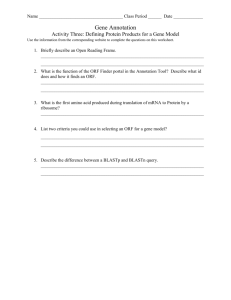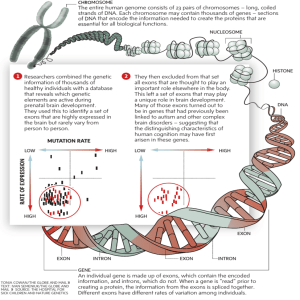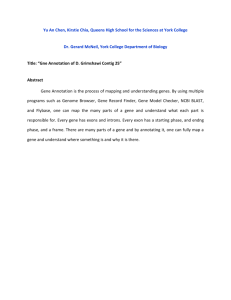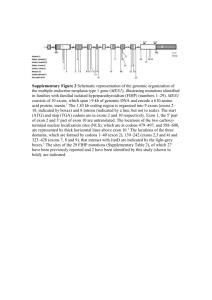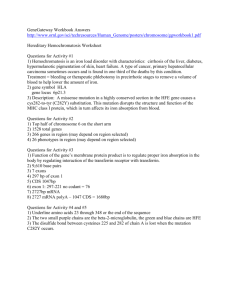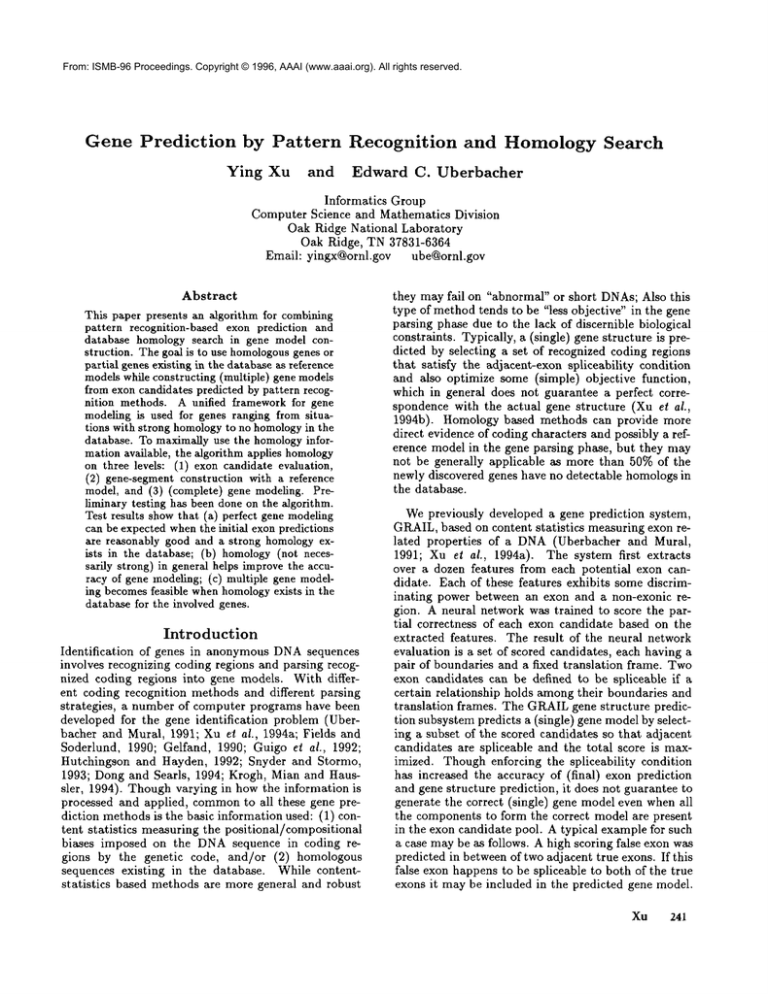
From: ISMB-96 Proceedings. Copyright © 1996, AAAI (www.aaai.org). All rights reserved.
Gene Prediction
by Pattern
Ying
Xu and
Recognition
Edward
C.
and Homology Search
Uberbacher
Informatics Group
Computer Science and Mathematics Division
Oak Ridge National Laboratory
Oak Ridge, TN 37831-6364
Email: yingx@ornl.gov ube@ornl.gov
Abstract
This paper presents an algorithm for combining
pattern recognition-based exon prediction and
database homology search in gene model construction. The goal is to use homologous
genes or
partial genesexisting in the database as reference
modelswhile constructing (multiple) gene models
from exon candidates predicted by pattern recognition methods. A unified frameworkfor gene
modelingis used for genes ranging from situations with strong homologyto no homologyin the
database. To maximallyuse the homologyinformation available, the algorithm applies homology
on three levels: (1) exon candidate evaluation,
(2) gene-segment construction with a reference
model, and (3) (complete) gene modeling.
liminary testing has been done on the algorithm.
Test results showthat (a) perfect gene modeling
can be expected whenthe initial exon predictions
are reasonably good and a strong homologyexists in the database; (b) homology(not necessarily strong) in general helps improvethe accuracy of gene modeling; (c) multiple gene modeling becomesfeasible whenhomologyexists in the
database for the involved genes.
Introduction
Identification
of genes in anonymous DNAsequences
involves recognizing coding regions and parsing recognized coding regions into gene models. With different coding recognition methods and different parsing
strategies,
a number of computer programs have been
developed for the gene identification problem (Uberbacher and Mural, 1991; Xu e* al., 1994a; Fields and
Soderlund, 1990; Gelfand, 1990; Guigo el al., 1992;
Hutchingson and Hayden, 1992; Snyder and Stormo,
1993; Dong and Searls, 1994; Krogh, Mian and Haussler, 1994). Thoughvarying in how the information is
processed and applied, commonto all these gene prediction methods is the basic information used: (1) content statistics measuring the positional/compositional
biases imposed on the DNAsequence in coding regions by the genetic code, and/or (2) homologous
sequences existing in the database. While contentstatistics
based methods are more general and robust
they may fail on "abnormal" or short DNAs;Also this
type of methodtends to be "less objective" in the gene
parsing phase due to the lack of discernible biological
constraints. Typically, a (single) gene structure is predicted by selecting a set of recognized coding regions
that satisfy the adjacent-exon spliceability condition
and also optimize some (simple) objective function,
which in general does not guarantee a perfect correspondence with the actual gene structure (Xu et al.,
1994b). Homology based methods can provide more
direct evidence of coding characters and possibly a reference model in the gene parsing phase, but they may
not be generally applicable as more than 50%of the
newly discovered genes have no detectable homologs in
the database.
Wepreviously developed a gene prediction systenl,
GRAIL,based on content statistics measuring exon related properties of a DNA(Uberbacher and Mural,
1991; Xu et al., 1994a). The system first extracts
over a dozen features from each potential exon candidate. Each of these features exhibits some discriminating power between an exon and a non-exonic region. A neural network was trained to score the partial correctness of each exon candidate based on the
extracted features. The result of the neural network
evaluation is a set of scored candidates, each having a
pair of boundaries and a fixed translation frame. Two
exon candidates can be defined to be spliceable if a
certain relationship holds amongtheir boundaries and
translation frames. The GRAILgene structure prediction subsystem predicts a (single) gene modelby selecting a subset of the scored candidates so that adjacent
candidates are spliceable and the total score is maximized. Thoughenforcing the spliceability condition
has increased the accuracy of (final) exon prediction
and gene structure prediction, it does not guarantee to
generate the correct (single) gene model even when all
the components to form the correct model are present
in the exon candidate pool. A typical examplefor such
a case maybe as follows. A high scoring false exon was
predicted in betweenof two adjacent true exons. If this
false exon happens to be spliceable to both of the true
exons it may be included in the predicted gene model.
Xu 241
Thoughit may not be universally applicable, homology information, when available, can be used to provide reference models in both exon prediction and gene
structure prediction. Somerecent work has been done
to incorporate homology information in the process of
exon (re)evaluation (Snyder and Stormo, 1994; Guigo
and Knudsen, manuscript in preparation).
We have developed a framework for incorporating
homology information in the GRAILgene prediction
process. Our goal is to maximally use the available
homology information in both exon prediction and
gene structure prediction. The framework consists of
three main steps: (1) exon candidate re-evaluation,
(2) reference-based gene-segment construction, and (3)
(multiple) gene structure prediction. The algorithm
first uses the GRAILexon prediction subsystem to predict a set of exon candidates. The predicted candidates
form a set of clusters, each containing overlapping exon
candidates. In general, each cluster represents different
predictions of a presumed exon with different boundaries. The algorithm then selects a few high-scoring
candidates from each cluster to do database homology
search. If homology is found, the search results are
processed to form a reference exon model for the cluster, and all the candidates of the cluster are re-scored
according to this reference model. In the next step, the
algorithm combines the search results for all the clusters to form a set of maximal reference models (.each
one covers more than one exon). An optimal partial
gene model, or gene segment, is constructed based on
each reference model. In the third step, gene models are constructed from the gene segments and exon
candidates by optimizing an objective function more
general than to the one used in Xu et al., 1994b. In
the actual implementation, steps 2 and 3 are combined
into one single step.
Preliminary tests have been done on this algorithm.
In general, as expected, incorporating homology information into the gene prediction process improves
the accuracy of individual exon predictions (mainly
boundaries of exons). By applying reference-based
gene-segment construction, the algorithm significantly
reduces the false positive rate by not including exon
candidates that are obviously inconsistent with the reference models. Based on our limited tests, a perfect
(single) gene model can be expected when the correct exon candidates are present in the candidate pool
and a strong homology exists in the database. The
database search also may provide information indicating the start and end of a gene, and hence makes automated multiple gene model prediction feasible.
Exon Prediction by Pattern
Recognition
This section reviews the GRAILexon prediction algorithm (Uberbacher and Mural, 1991; Xu et al., 1994a;
Uberbacher el al., 1996). As in any pattern recognition problem, to recognize exons we need to select a set
242
ISMB-96
of features that are associated with exons, and to design a method to discriminate exons from non-exonic
regions.
To determine the likelihood of a DNAsegment being an exon involves determination of coding potentials of the region and evaluation of the potential splice
junctions (or translation starts/stops) boundingthe region. GRAILuses a frame-dependent 6-tuple preference model (Uberbacher and Mural, 1991; Claverie et
al., 1990) and a th order n on-homogeneous Markov
chain model (Borodovskyel al., 1986) to calculate coding potentials of each candidate region and its two
60-base surrounding regions (as background signal).
These coding measures are used as features in the exon
discrimination process.
Recognition of coding regions using the 6-tuple (or
in general k-tuple, for any fixed k) methodis knownto
have strong dependence on the G+Ccomposition, and
is more difficult in G+Cpoor domains. If we estimate
the frequencies of frame-dependent coding 6-tuples and
noncoding 6-tuples in the high G+Cdomain, and use
these frequencies to calculate coding measures for a
set of coding regions and their 60-base flanks in all
ranges of G+C composition, an unexpected pattern
is shown in Figure 1. The coding measures for both
the coding regions and their flanks are muchlower ill
the G+C poor domain compared to the G+C rich domain. A very similar behavior is observed if the 6tuple frequencies are collected from low G+C DNA
sequences. Hence GRAILuses the G+C compositions
of both a candidate region and a 2000-base region centered around the candidate as correction factors in the
exon discrimination process.
A number of measures including a 5-tuple preference model, long-distance correlations between single
bases, etc. have been used in a separate process for
evaluating the strength of a potential splice junction.
The result of this evaluation is used as a feature in the
exon discrimination process.
One interesting observation we recently made indicates that shorter exons tend to have stronger splice
junction sites and hence higher scores. Also short
false exon candidates may have better chance to accidentally have high coding measures. Based on these
considerations, we have included the exon candidate
length as another feature in the exon discrimination
process.
The extracted features over each candidate region
are fed to a neural network, which has been trained to
score the partial correctness of a candidate. The result
of the neural networkevaluation is a set of scored candidates with each having a fixed translation frame. A
clustering procedure divides the candidates into clu~
ters of overlapping candidates, each of which rcprcsents
a different prediction of a presumedexon.
[]
0
on
0
0
0
I
I
I
Figure 1: The X-axis represents the G-4-C composition of an exon candidate and Y-axis represents the 6-tuple
scores measured by the frame-dependent preference model. Each tick mark on the horizontal axis represents 10%
in G+Ccomposition with 0% on the left and 100% on the right. The large squares represent the coding regions
and the small dots represent the regions flanking coding regions.
Database Homology Search
By doing database search, we attempt to achieve the
following goals: (1)to collect "sufficient" information
to help locate where the corresponding coding region
starts and ends for each candidate cluster; (2) to collect
as muchinformation as available to piece together protein segments to form long, hopefully complete protein
sequence(s) (in the sense of a complete gene).
In the current implementation, we use Swissprot as
the target database. The search for homology is done
by the FASTAprogram version 2.0 (Pearson and Lipman, 1988) using the score matrix BLOSUMh0.Experiments on other databases with different search programs are expected to be done in the near future.
To conduct a database search, an exon candidate is
first translated into a protein sequence in its translation frame, and then this protein sequence is used as a
query in the search. For each search, FASTAreturns
a number of hits from different proteins, possibly of
different organisms. A typical FASTAhit is shown in
Figure 2.
For each database hit, the following information can
be extracted: (1) the starting and ending positions
the matched portion of the query sequence, from which
we can calculate the starting and ending positions of
the corresponding coding DNAsegment; (2) the portion (subsequence and location) of the protein that the
query sequence matches, from which we can further
knowif this portion is the beginning or end of the protein, or somewherein between.
1In the current implementation, we use the top five
highest-scoring candidates from each cluster to do the
database search. The reason we use five instead of one
or all candidates of a cluster is due to the consideration
of (1) having a good representative set, and (2)
computation time constraint. The search results are
sorted into different gene groups. For each group, the
union of the matched protein portions is used as the
reference model(this is a simplified statement but gives
the basic idea). Thus each cluster has a number of
reference models from different genes.
After the database search is done for all the clus1Weuse as manyhits as returned by the search if less
than five are found.
Xu 243
10
20
query
30
40
50
60
MADFIRGVVDSEDLPLNISREMLQQSKILKVIR
::::::::::::::::::::::::::::::
genel
query
TRKKMNNIKLVVRRVFIMDNCEELIPEVLGFVKGVVDSDDLPLNISREMLQQNKILKVIR
BO
90
100
110
120
130
70
80
90
KNIVKKCLELFSELAEDKENYKKFYEAFSKNLK
:::::::::::::::::::::::::::::::::
genel
KNLVKKCIEMFNEIAENKEDYNKFVEAFSKNLKLGIHEDSQNRAKLADLLRVHSTKSGDE
140
150
160
170
180
190
Figure 2: An example of FASTAsearch result.
ters, matched protein segments are sorted into different gene groups. A set of non-overlapping maximal
gene segments are formed based on the protein segments obtained from the search for each gene group
(note that each protein segment could be longer than
the matched portion of the protein as can be seen in
Figure 2). These gene segments will serve as reference
models in the reference-based partial gene model construction. Labels are marked on gene segments that
start and/or end a gene, which will be used ill the
multiple gene model construction.
Gene Modeling
Gene model construction is currently done in GRAIL
by selecting a subset of non-overlapping exon candidates from the predicted candidate pool such that adjacent candidates (in their spatial relationship) satisfy the following spliceability condition and the total
(normalized) neural-net score is maximized(Xu el al.,
1994b). WeclassiC" exons into three classes: (1) initial
axons: the exons that start with a translation start
ATG, (2) internal exons: the exons that start with
an acceptor junction and end with a donor junction,
and (3) terminal axons: the exons that end with a inframe translation stop codon. Note that an exon can
be both initial and terminal exon. An exon E1 is said
to be spliceable to exon E2 if the following conditions
hold. Weuse l(E), r(E) and f(E) to represent the left
boundary, right boundary and translation frame of E,
respectively.
(1) E1 is a non-terminal cxon, and E2 is a non-initial
exon;
(2) l(E2) - r(E1) > KS, (in GRAIL,kq = 60);
(3) :(E2)= (t(E2)- r(E1)- 1 +/(El))3;
(4) no in-frame stop are formed at the joint point
when appending E1 to E2.
The basic assumption for such a mathematical model
for gene modeling to be effective is that the score of
an exon candidate is, in general, an accurate reflection of the partial correctness of it being a true exon.
Whenthis assumption is violated we maysee that highscoring false candidates are included in the gene model,
244
ISMB-96
or low-scoring true exons are excluded from the gene
model. The problem is caused by a lack of detectable
biological constraints used in this mathematical model.
In this section, we extend this model by applying
homologyinformation in addition to spliceability condition when appending exon candidates to form a gene
model. Because of the markers of the start/end of a
gene from the database search, we can further extend
this model to construct multiple gene models.
Exon re-evaluation
For each cluster, all the candidates will be re-scored
based on the reference models if the homologyis above
some threshold. Let E be an exon candidate, P be
its corresponding protein, and R be a reference model.
P~ecall the format of a FASTA
output. Wereplace each
identity match (":") between P and R by a value
each similar match (".") by 0.5 and a miss match by
The total of all these values is defined to be the match
score between P and R, denoted by match(P, R). The
new score of E witil respect to the rcference model R
is given by
scoreR(E) match(P, R) 2
IIRll ’
where IIRll represents the cardinality of R.
To be consistent in the scoring scheme, we also rescore the exon candidates with no database homology
as follows (note that the neural net score does not explicitly reflect the length of a candidate but the above
does). For each such candidate E, let net(E) represent
E’s neural net score (scaled to the range of [0,1]).
scorm(
E)=net(E)~’llEII/3,
where 0 indicates that the score does not depend on
any reference modeland IIEII/3 gives the length of E’s
corresponding protein. Wealso define ~coreR(E)
-oc for all such E’s.
Reference-based
gene model construction
This subsection presents an algorithm for constructing
a (multiple) gene model from a set of predicted exon
candidates that. maximizes the total exon candidate
scores under the constraint that the modelis consistent
with a set of given reference models.
An example Wefirst use an example, shown in Figure 3, to explain the basic idea of the algorithm. In
this example, every cluster except clusters number 7
and number 11 has some homology in the database.
To make our discussion simple, we assume that the
homology between R/’s and the corresponding DNA
segments is strong. Wewant to construct a gene model
that are the most probable based on the given neural
net scores and the homology information. Recall that
the neural net scores of the candidates in Figure 3(b)
represent the confidence level of a candidate being an
exon without any knowledge of database homology. In
our early work (Xu et al., 1994b), the most probable
gene model is totally determined by these scores. Our
new algorithm has extended this to the following strategy: apply homology information whenever possible,
otherwise use neural network scores.
Note that each of the 5 reference models in Figure
3(c) is part of a protein possibly from different organisms, and these reference models could be inconsistent.
Weneed to determine, for each exon candidate, which
reference model to use while constructing a gene model.
Our strategy is to use as few reference models(of highest quality) as possible under the condition that the
maximumnumber of clusters are covered by these reference models. The rationale is that fewer number of
reference models implies fewer splicings between exons
covered by different reference models, or put it differently, more splicings between exons covered by the
same reference model.
Based on the above discussion, a possible optimal
gene model for this example could be {E1,E2, E3,
E4, E~, E6, Es,9, El0, Ett}, and the reference models
are R5 and Rs, where Ei is from cluster number i,
for i E {1,2,3,4,5,6,10,11}
and Es,9 is a candidate
from cluster 8 or 9. Cluster number 7 (marked by "*")
is excluded because of its inconsistency with the reference model Rs. Inclusion of a candidate from cluster
11 will increase the total score and does not cause any
inconsistency with any reference model. Thus Ell is
part of the gene model.
The problem Our goal is to define and solve the
reference-based multiple gene modeling problem. But
first we define a simpler problem, the reference-based
partial gene modeling problem, which models a single
gene and does not require a gene model to start with
an initial exon and to end with a terminal exon.
We first introduce some notations. Let C denote
the set of all candidates and {R1,..., Rk} be all the
reference models. We add a special R0 = 0 to the
reference model set to simplify the notations. For each
E E C and each R./, M(E, Ri) represents the portion of
Ri that matched E’s corresponding protein (by FASTA
version 2.0). M(E, P~) = 0 if there is no match.
A reference-based partial gene modeling problem
is defined as follows. We want to select a subset
{El, ..., E,,} of non-overlapping candidates from C and
a mappingR from {Ex, ..., E,} to {R0, ..., Rk} so that
the following function is maximized. Weassume that
(E1)<...
maximize
+
~i:l se°reR(E.)(Ei)
P(R(Ei-O, R(Ei))
subject to:
(1) Ei is spliceable with Ei+l for all
i ¯ [1,n- 1],
(2) R(Ei) = R(Ej) and i < j implies
r(M(E. R(E,))) < I(M(Ej, R(Ej))).
where P(X,Y) = if X =Y and X ~ 0 ot herwise
P(X,Y) 0, andP is us ed to re ward splic ings between exons with the same reference model.
Informally, we want to select a number of exons
Ex,..., E,~ from C and a reference model for each Ei
so that the total scores of these exons is maximized.
Such a set of exons should satisfy the adjacent-exon
spliceability condition, and also the relative order of
exons should be kept in their matched portions in the
reference model. To encourage to use the same reference model for adjacent exons, we also add a reward
factor in the objective function for splicings between
adjacent exons using the same reference model. In our
current implementation, :P is chosen to be larger than
the score of one "average" false candidate.
In the general reference-based gene modeling problem, we also include the information about the start
and the end of a gene. For each exon E and a reference model Ri, we define B(E, Ri) = 1 if M(E, R/) is
prefix of R/’s corresponding protein, and B(E, Ri) =
otherwise. Similarly, L(E,R~) = 1 if M(E, Ri) is a
suffix of R./’s corresponding protein, and L(E, R~) =
otherwise.
A reference-based multiple gene modeling problem is
defined as follows. Wewant to find a list {El, ..., En}
of non-overlapping exon candidates from C, a mapping R from {El, ..., En} to {R0, ..., Rk}, and a par1
tition of {El .... ,En} into D sublists, {E~,-.-, E~(t)},
" ...,E~(2)},
. ......{E D,, E~(D)},
so that the
{Ei’,
~
D
lowing function is maximized, where e(d) represents
the last exon of the d th sublist.
We assume that
r(E1) < ... < r(E,O.
Xu 245
l i 1 I
1 I [7 1 1 1
I
1
1 1
1
-I]I...........
(c)
Figure 3: A schematic of a candidate cluster and database homology. The X-axis represents the sequence axis.
(a) and (b) represent a set of clusters. Each hollow rectangle in (b) represents an exon candidate. The width
a rectangle represents the size of the candidate and the height represents the "probability" it being a true exon,
scored by the neural net. The symbols in (a) indicate the eleven clusters these candidates form. Each R~ in (c)
represents a continuous gene segment or reference model. A short line of each Ri represents the matched portion
with the corresponding DNAsegment, and the broken gaps are only used to indicate the reference model matches
a number of DNAsegments. There are five reference models in this example.
maximize
subject to:
for all g E [1, D],
(1) l(E1,(.-n~-l~) - r(Ea,G..~) > £, for
g<D,
(2) i(Ea~(a), R(E~(a)))= 1, or
a+l, R(Ela+I)).
B(E1
- 1,forg < D,
(3) B(E~, R(E~)) = 1 implies p = 1,
andL(E~,R(E~))= 1 implies q = e(g),
(4) E~ is spliceable with E~+1 for all
i e [1, e(g)- 1],
(5) R(E~) -- R(E]) and i < j imply
r(M(E[, R(E[))) < I(M(E],
where penalty factor 7)I (E) is a fixed negative value
E is not an initial exon otherwise it is zero, similarly
~Ot(E) is a fixed negative value if E is not a terminal exon, otherwise it is zero, and £ is the minimum
distance between two genes (£ = 1000 in our current
implementation). Note that D is not a predetermined
value, but a part of the optimal solution. In the following, we say { El,..., E,,} form a gene model under
246 ISMB--96
mappingR and the partition given above if conditions
(1)- (5) hold.
The main difference between the general gene modeling problem and the partial gene modeling problem
is the treatment of the start and the end of a gene.
By utilizing the information about the start/end of a
gene from the database search, we are able to deal with
multiple genes in a DNAsequence. By requiring conditions (2) and (3), a list of exons will be divided
two genes if and only if there is a start or end of a gene
based on the database search information. To model
a complete gene, we penalize gene models missing the
translation start in its first exon or the translation stop
in its last exon by using the two penalty factors ~oI and
P,.
The algorithm
We now present a dynamic programmingalgorithm to solve the reference-based multiple gene modeling problem defined above. The partial gene modeling problem can be solved as a special
case.
The input to the algorithm is a set of exon candidates sorted in the increasing order of their right
boundaries. The algorithm scans through the exon
candidates from left to right and constructs optimal
solutions for the subset containing all candidates from
the first to the current one, based on optimal solutions for previous subsets. Wecall these solutions the
optimal solutions for this candidate. For each candi-
date, at most k + 1 optimal solutions are constructed,
i.e., at most one for each of the k + 1 reference models {R0, R1,..., Rk}. To construct an optimal solution
for the candidate and a reference model, the algorithm
tries to splice this candidate with all the previous candidates, and to find the one giving the highest total
score with respect to the reference model. P is rewarded to each splicing between candidates using the
same reference model. Conditions (1)- (5) are checked
while trying to splice two candidates. The algorithm
stops when all candidates are processed. The model
having the highest total score is output as the solution. As we give more details in the following, it can
be seen that this output corresponds to the solution to
the reference-based multiple gene modeling problem.
Let {El, ...,EIIcll } be the set of given exon candidates sorted in the increasing order of r(Ei)’s.
use model(Ei,RJ to denote the value of the objective function of the optimal gene model, for the subset
{El,..., Ei}, that ends with Ei using reference model
Rj. By definition,
max model( Ei , Rj
ie[a,,q,j e~,k]
corresponds to the solution of the reference-based multiple gene modeling problem.
To calculate model(Ei,Rj), the following recurrences can be proved using inductive proofs, which we
omit here. To simplify the recurrences, we introduce
another quantity modelo(Ei, Ri), which is defined the
same as model(Ei, Ri) except that the P~0 term (in
the objective function) is ignored for the last sublist in
the partition of {El, ..., El}.
There are two cases we need to consider in calculating both model(Ei, Rj) and modelo(Ei, Rj).
Case # I: WhenEi is the first
exon of a gene,
model(Ei, Ri) = maxp¢~t,i-1],qe~0,k]
{model(Ei, nj), model(Ep, nq) + scorenj (Ei)+
Py(Ei) + 7~(Ei),when L(Ep,Rq)= 1 or
B(E,, Rj) = 1, (2) I(E,) - r(Ep) > £.}
and
modelo(
Ei, Rj ) = maxpe[.t,i_ l],qe[~,k
]
{ modelo
( E~, Rj ), modei( Ep, Rq) +seoreR j ( Ei
T’/(Ei),when (1) L(Ep,Rq)= 1 or B(Ei,Ri) =
(2) l(Ei)- r(Ep) > £.}
Case # ~: WhenEi is not the first exon of a gene,
model(Ei, Rj)
] = maxpe[a,i_ll,qe[~,k
{ model( Ei, Rj ), modelo(Ep, Rq) + score R~ (El)+
P(Rq, Rj) + "P~(Ei), when (1) Ep is spliceable
Ei, (2) L(Ep, Rq) = 0 and B(Ei, Rj) = O, (3)
r(M(Ep, Rq)) l( M(Ei, Rj )) if Rq = Ri. }
and
]modelo(Ei , Rj ) : maxpe[.1,i_ll,qe[O,k
{modelo( Ei, Rj ), modelo( Ep, nq) + scoreR, (Ei)+
P( Rq, Rj ), when(1) Ep is spliceable to Ei, (2)
L(Ep, Rq) = 0 and B(Ei, Rj) = 0, (3)
r(M(Ep, Rq)) < l(M(Ei, if Rq : R i. }
In the general case, model(Ei, Rj) equals the highest value of the two cases. The same is true for
modelo(Ei, Rj). The initial values of model(Ei, Rj)
and modelo(Ei, Rj) are defined as follows.
modet(E
, I%)= seo,’eR(EO
+
modelo(E,, nj) = scoreR,(E,) + :Py(E,).
Using these recurrences, model(Ei, Rj) can be calculated in the increasing order of i for all j E [0, k]. It
is easy to see that these quantities can be calculated in
O(l[CII2k 2) time and O(llC[Ik ) space. To recover the
set of candidates that achieves max/,j model(Ei, Rj)
some simple bookkeeping needs to be done, which
can be accomplished in O(llC[12k2) time and O(llCI]k
)
space. Weonfit further details.
Figure 4 shows an example of reference-based gene
modeling. An interesting thing is that the best reference models for the first two exon clusters are not
Humanbut Mouse proteins while the best reference
models for all the other clusters are Humanproteins.
Database search results show that the matches with
Mouse proteins are 100% but only 96.6% with Human
proteins for both clusters.
Results
and Discussions
We have presented a framework for using homology
information to guide gene structure predictions. The
framework uses exons predicted by content-statistics
based methods as basic building blocks and database
homology information as references in constructing
gene models. The mathematical model we used for the
gene modeling problem rewards any application of homology information in the gene modeling process as an
attempt to maximally use the known homology. Minimal "inconsistency" between predicted gene structures
and database homologyis the basic rule used in this
gene modeling framework.
Preliminary tests have been done to test the effectiveness of applying homologyinformation in gene
modelings. Based on the test results on 59 genes, we
conclude that (1) homologyinformation has helped improve the prediction accuracy of exon boundaries in
the (single) exon re-evaluation step, (2) homologs
responding to a series of exons has helped greatly in
eliminating false exons, and also has further helped improve the exon boundary predictions, and (3) the availability of information about the start/end of a protein
makes it feasible to do multiple gene modeling.
The following table lists the test result on 59 single
genes. While conducting these tests, the gene tested
Xu 247
|
|
ml| |
I
| |
m
|
Hires
¯
|
|
(d)
House
Human
Figure 4: Reference-based gene modeling. The X-axis represents the sequence axis. (a) Each solid bar represents
an exon. (b) The predicted exons and gene structures. The lines between solid bars represent splicings between
exons of the same gene. (c) The neural net predictions of exon candidates. The Y-axis represents the axis
exon scores. (d) The re-scored exon candidates using homologyinformation. The lines in the bottom indicate the
reference models used in gene segment construction.
The sequence is HUMIFNRF1A.
on is removed from the database. The first column in
the table gives the sequence name and the number of
exons in this sequence. The Exons columns give the
prediction performance in terms of number of exons
that are "correctly" and falsely predicted; Welist the
numberof missing exons and false exons if there is any
(a blank means no missing and false exons). Similarly
the Edges columns give the number of exon boundaries that are incorrectly predicted.
From Table I, we can see that the reference-based
gene modeling program has improved the performance
of the GRAILgene prediction system. This program
has reduced the number of false exons, missing exons
and off-edges from 22 to 3, from 27 to 19, and from
57 to 17, respectively. There are a few cases where
the GRAILgene prediction subsystem misses more exons than the reference-based gene modeling program
does. The reason for this is that these missed exons
are predicted by the GRAILexon prediction program
but not included in the gene models due to the incorrect exon boundary predictions and the enforcement
of spliceability condition. The exon re-evaluation program corrected these exon boundary predictions based
on the database search results, and hence these cxons
are included in the reference-based gene modeling.
Tests are also done on a number of multiple gene se248
ISMB-96
quences. Figure 5 shows one example of multiple gene
modeling on a DNAsequence artificially
formed by appending three sequences HUMCYPIIE, HUMRASH,
HUMACTGA.
While we are planning to conduct more extensive
tests on the algorithm, the preliminary test results
have pointed to possible directions for further improvement on the algorithm. Wemention a few here. While
our current reference-based gene modeling framework
allows effectively removingfalsely predicted exons and
correcting exon boundary predictions, it does not support mechanism to generate exons missed by the neural network exon predictor. Some work is currently
under way to develop effective methods to generate
those missed exons based on the information provided
by database search. Weare also working on schemes
to include even more biological constraints in the multiple gene modeling process, for example, indications
of promoters, CpGislands, PolyA sites, etc.
In conclusion, we have generalized our previous
algorithm for single gene model constructions and
developed a reference-based multiple gene modeling
framework. This framework attempts to maximally
use the available homologyinformation from existing
databases in constructing gene models. By combining
content-statistics
based pattern recognition methods
(b)
I I
III
I
II
m
¯
m m m
iN m
m
m
¯ mm
i im
m
i
I
IIII
IlllU
~
I)I))I
(cO
Figure 5: Multiple gene modeling. The X-axis represents the sequence axis. The DNAsequence is artificially
formed by appending HUMCYPIIE,HUMRASH
and HUMACTGA.
(a) Each solid bar represents
an actual exon.
Exons # 1 through # 9 are the exons of HUMCYPIIE,
exons ~ 10 to ~ 13 are the exons of HUMRASH,
and exons
~: 14 to # 18 are the exons of HUMACTGA.
(b) The predicted exons and gene structures by the reference-based
gene modeling program. The lines between solid bars represent splicings between exons of the same gene. (c) The
neural net predictions of exon candidates. The Y-axis represents the axis of exon scores. (d) The re-scored exon
candidates using homology information.
and homology information, this reference-based gene
prediction program should provide molecular biologists
a more powerful and convenient tool in gene identification.
Acknowledgements
This research was supported by the United States
Department of Energy, under contract
DE-AC0584OR21400 with Lockheed Martin Energy Systems,
Inc.
References
M. Borodovsky, Yu. Sprizhitskii,
E. Golovanov and
A. Aleksandov, "Statistical
Patterns in the Primary Structures of Functional Regions in E. Coli.",
Molekulyainaya Biologiya, Vol. 20, pp. 1390- 1398,
1986.
M. Burset and R. Guigo, "Evaluation of Gene Structure Prediction Programs", Preprint, 1996.
J. M. Claverie, I. Sauvaget and L. Bougueleret, "ktuple Frequency Analysis: From Intron/Exon Discrimination to T-cell Epitope Mapping", Methods in
Enzymology, Vol. 183, pp. 237- 252, 1990.
S. Dongand D. B. Searls, "Gene Structure Prediction
by Linguistic Methods", Gcnomics, Vol. 23, pp. 540 551, 1994.
C. A. Fields and C. A. Soderlund, "GM: A Practical Tool for Automating DNASequence Analysis",
Comput.Appl. Biol. Sci., Vol. 6, pp. 263 - 270.
M. S. Gelfand, "Computer prediction of Exon-Intron
Structure of Mammalianpre-mRNAs", Nucleic Acids
Res., Vol. 18, pp. 5865- 5869, 1990.
R. Guigo, S. Knudsen, N. Drake and T. Smith, "Prediction of Gene Structure", J. Mol. Biol., Vol. 226,
pp. 141 - 157, 1992.
G. B. Hutchinson and M. R. Hayden, "The prediction of Exons Through an Analysis of Spliceable Open
Reading Frames", Nucleic Acids Rcs., Vol. 20, pp.
3453- 3462, 1992.
A. Krogh, I. S. Mian, and D. Haussler, "A Hidden
Markov Model That Finds Genes in E. Coil DNA",
Preprint, 1994.
V. R. Pearson and D. J. Lipman, "Improved Tools for
Biological Sequence Comparison", Proc. Natl. Acad.
Sci. USA, Vol. 85, pp. 2444 - 2448, 1988.
E. E. Snyder and G. D. Stormo, "Identification
of
Coding Regions in Genomic DNASequences: An Application of Dynamic Programming and Neural Networks", Nucleic Acids Res., Vol. 21, pp. 607 - 613,
1993.
E. E. Snyder and G. D. Stormo, "Identification
of
Protein Coding Regions in Genomic DNA", J. Mol.
Biol., Vol. 248, pp. 1 - 18, 1995.
Xu 249
E. C. Uberbacher and R. J. Mural, "Locating Proteincoding Regions in Human DNA Sequences by a Multiple Sensors-neural
Network Approach", Proc. Nail.
Acad. Sci. USA, Vol. 88, pp. 11261 - 11265, 1991.
E. C. Uberbacher,
Y. Xu and R. J. Mural, "Discovering
and Understanding
Genes in Human DNA
Sequence using GRAIL", Methods in Enzymology, in
press, 1996.
Table I: Test results
GRAIL
Sequence
HUMALIFA (3)
ExonB
Edges
1 off
GRAIL
with db search
Exons
Edges
1 false
HUMALPHA (11)
Y. Xu, J. R. Einstein, R. d. Mural, M. Shah and E. C.
Uberbacher, "An Improved System for Exon Recognition and Gene Modeling in Human DNASequences",
Proceedings of the Second International
Conference
on Intelligent
Systems for Molecular Biology, Altman,
Brutlag, Karp, Lathrop and Searls, Eds., pp. 376 384, 1994a.
HUMAPOE4 (3)
Y. Xu, R. Mural and E. C. Uberbacher: "Constructing Gene Models from a Set of Accurately-predicted
Exons: An Application
of Dynamic Programming",
Computer Applications
in the Biosciences,
Vol. 10,
pp. 613- 623, 1994b.
HUMBMYH7(38)
1 off
1 miss
HUMAPRTA (5)
HUMATPGG (22)
1 miss
2 off
1 miss
1 off
1 miss
1 off
HUMATPSYB (10)
HUMCACY(2)
1 off
3 miss
1 false
1 miss
3 miss
2 off
2 off
HUMCAPG (5)
HUMCYPIIE (9)
1 miss
1 false
1 off
1 off
1 miss
HUMEDHB17 (6)
HUMEF1A (7)
HUMFESFP (18)
]
miss
1 off
1 off
HUMGLUT4B (11)
HUMGOS24(4)
HUMttAP (4)
HUMHOX4A (2)
1 off
HUMHSD3BA (3)
HUMHSKPQZ7 (6)
HUMHSP90B (11)
HUMIBP3 (4)
2 off
1 false
2 off
HUMIFNRFIA (9)
HUMILIB (6)
HUMIL2 (4)
HUMIL4A (4)
HUMIL5 (4)
HUMKERlS (7)
1 miss
HUMMETIII (3)
1 miss
HUMMHB27D (7)
250
ISMB-96
1 off
1 false
1 miss
1 miss
2 off
1 off
1 miss
1 off
HUMMHCP42 (10)
3 off
1 false
1 miss
HUMMKXX(4)
HUMMLHDC(12)
1 off
1 miss
8 off
2 miss
2 false
1 false
2 miss
1 off
2 miss
1 miss
2 off
1 miss
2 miss
5 false
3 off
HUMMRPSA (2)
HUMMYCC (2)
HUMOSTP (6)
HUMPALD (4)
HUMPCNA (6)
HUMPDS02 (5)
2 off
ttUMPF4VIA (3)
HUMPGAMMG (3)
ttUMPIM1A (6)
HUMPNMTA (3)
1 off
HUMPOMC (2)
HUMPRFIA (2)
2 off
HUMPSAA (5)
HUMSERG (2)
tIUMSFTP1A (4)
1 miss
2 false
1 miss
1 false
2 off
1 false
1 off
2 off
1 off
1 off
1 miss
1 false
HUMSODA(10)
HUMSPERSYN (8)
HUMTBB5 (4)
HUMTCRBRA (2)
1 false
1 miss
HUIvITHB(14)
1 miss
2 off
1 miss
HUMTNC2 (5)
1 miss
2 off
1 miss
1 false
1 miss
3 off
1 off
1 miss
1 miss
1 off
HUMTNFBA (3)
HUMTROC (6)
HUMTRPM2A
(3)
HUMTRPYIB (5)
HUMUBILP (4)
HUMVITBP (12)
2 off
1 miss
2 fMse
3 miss
2 false
2 off
2 off
1 miss
1 off
3 off
3 miss
3 off
Xu
251

